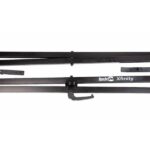If you’re a trombone player, you may have experienced the frustrating problem of a sticking slide.
When your trombone slide doesn’t move smoothly, it can significantly impact your ability to play with precision and fluidity. It can hamper your musical performance.

In this article, we will delve into the reasons behind a sticking trombone slide. We will also provide comprehensive steps to fix it effectively.
So, whether you’re a beginner or a seasoned trombonist, you must understand the causes and solutions for this common issue.
Read on to Restore your trombone’s slide to its optimal condition. Regain the joy of playing with seamless glissandos and smooth transitions between notes.
Contents
Common Causes of a Sticking Trombone Slide
Here are the common causes why your trombone slide sticking and how you can fix it:
1. Sticky Residue
One common cause of a sticking trombone slide is the accumulation of sticky residue.
Over time, moisture, saliva, and lubricants can leave behind deposits on the inner surfaces of the slide. It makes it difficult to move freely.
As you play the trombone, saliva, and moisture from breath create a sticky film. Lubricants used for slide action can also add to the residue buildup.
This stickiness acts as a barrier, causing friction and hindering slide movement.
The sticky residue not only affects the performance of your trombone but can also lead to discomfort while playing.
It can cause jerky slide motion, resulting in imprecise pitch changes and hindering your ability to express yourself musically.
What to do:
- Start by disassembling the slide. Carefully remove the outer slide from the inner slide, ensuring you keep track of any small components or attachments.
- Prepare a cleaning agent by mixing warm water with mild detergent. Avoid using harsh chemicals or abrasive substances that can damage the instrument.
- Submerge the slide in the cleaning solution and let it soak for a few minutes. It helps to loosen and dissolve the sticky residue.
- Using a trombone cleaning snake or a brush specifically designed for slide cleaning. Gently scrub the inner surfaces of the slide tubes. Pay special attention to areas where the residue is more prominent, such as near the stocking or slide bow.
- Rinse the slide thoroughly with clean water to remove any residual cleaning solution and loosened residue. Ensure that all the residue is washed away.
- After rinsing, carefully dry the slide using a clean, lint-free cloth. Remove all moisture from the inner and outer surfaces of the slide to prevent any potential corrosion.
- Once dry, reassemble the slide by carefully aligning the inner and outer slide tubes. Ensure a proper fit without any misalignment or obstruction.
- After reassembling, apply a suitable trombone slide lubricant to the inner surfaces of the slide tubes. Follow the manufacturer’s instructions for the recommended amount of lubricant to use.
- Spread the lubricant evenly along the slide tubes using your fingers or a cloth. Ensure that the entire length of the tubes is coated. It will provide smooth and frictionless slide action.
- Then, wipe away any excess lubricant with a clean cloth. Leave a thin, even layer that will facilitate effortless movement of the slide.
2. Misalignment

Misalignment between the inner and outer slide tubes can lead to a sticking trombone slide.
This misalignment can occur due to various factors, such as improper assembly, accidental knocks, or general wear and tear.
Misaligned slide tubes can cause binding or catching at specific positions, impeding smooth slide movement. It leads to a jerky or sticky slide action.
It makes it difficult to transition between positions and affects overall precision during play.
Identify misalignment by observing and testing the slide. Slide the inner tube within the outer tube slowly, noting any resistance or catching. Irregularities or jerky movement indicate misalignment as the cause of the sticking slide.
What to do:
- Start by loosening any screws or nuts securing the trombone slide. It allows for slight adjustments without damaging the instrument.
- Slowly and gently move the inner slide tube within the outer slide tube, testing for smoothness and evenness of movement. Pay close attention to any areas where the slide catches or feels resistant.
- As you identify areas of misalignment, try gently nudging the tubes back into alignment using careful and controlled pressure. Be cautious not to use excessive force, which can cause further damage.
- Continuously test the slide’s movement and gradually adjust until you achieve improved alignment. Take your time and proceed with patience to ensure accurate realignment.
Realignment of a trombone slide requires expertise. Consult a professional repair technician if you need more clarification or are uncomfortable with adjustments. They have the knowledge, tools, and experience to realign the slide without causing further damage.
3. Lack of Lubrication
Insufficient lubrication is another common cause of a sticking trombone slide.
The inner surfaces of the slide tubes need proper lubrication to ensure smooth movement. Without it, increased friction leads to a sticky or sluggish slide action.
With time and regular play, the lubricant on the slide can wear off or dry out. This lack of lubrication leads to resistance, hindering position changes and overall playability.
What to do:
- Select a high-quality trombone slide lubricant specifically designed for brass instruments. Avoid household oils or substitutes, as they may not provide the necessary lubrication and can damage the slide.
- Disassemble the slide by carefully separating the outer and inner slide tubes. Please take note of any small components or attachments to ensure they are not misplaced.
- Clean the inner and outer slide tubes using mild detergent and warm water. This step removes any dirt, residue, or old lubricant that may be present.
- After cleaning, thoroughly dry the slide tubes with a clean, lint-free cloth. Ensure that no moisture remains on the surfaces to prevent any potential corrosion.
- Apply a small amount of the trombone slide lubricant to the inner surfaces of the slide tubes. Start at one end of the tubes and spread the lubricant evenly along the length using your fingers or a cloth.
- Work the slide back and forth several times to distribute the lubricant and ensure complete coverage. It helps create a smooth and consistent layer of lubrication.
- Wipe away any extra lubricant with a clean cloth, leaving a thin, even layer on the slide tubes. Excess lubricant can attract dust and debris, leading to potential issues in the future.
4. Dents or Damage

Dents or damage to the trombone slide also cause sticking or uneven movement. Accidental bumps or mishandling can result in dents or bends, compromising smooth operation.
Wear and tear over time also affect slide performance with minor dents or imperfections.
Dented or damaged slide tubes obstruct air passage, causing friction and sticking at certain positions. It hinders fluidity, affects the intonation, and impacts sound quality.
What to do:
- Observe for any dents, damages, or signs of wear and tear on your trombone slide instrument.
- If you find dents or damage, consult a skilled technician to asses or repair the slide.
Repairing dents or damage requires a skilled professional specializing in brass instrument repair.
DIY attempts without the expertise and proper tools risk further damage or compromise the slide’s integrity.
Conclusion
Addressing a sticking trombone slide is crucial for maintaining smooth and effortless playability.
Whether it’s sticky residue, misalignment, lack of lubrication, or dents and damage, each issue requires specific attention.
Regular cleaning, proper lubrication, and seeking professional assistance for severe damage are significant steps in resolving these problems.
By following the recommended actions and maintaining your trombone slide, you can overcome sticking and enjoy optimal performance.
Remember to practice good maintenance habits to prolong the lifespan of your instrument and enhance your musical experience.
With a well-maintained slide, you can achieve seamless transitions, precise intonation, and an overall improved playing experience.






